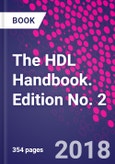The HDL Handbook: Biological Functions to Clinical Implications brings laboratory research in HDL from bench to bedside in this needed resource for researchers and clinicians studying cholesterol, lipids, epidemiology, biochemistry, molecular medicine, and pathophysiology of cardiovascular diseases. In addition, researchers and clinicians working with an aging population, corporate researchers, post-doctorates; medical students and graduate students will find this publication useful because the scope of coverage includes basic science, genetics, epidemiology, and treatment of HDL cholesterol as well as potential targets to modify HDL cholesterol.
- Provides bench-to-bedside coverage of HDL with thorough coverage of basic science, genetics, epidemiology, and treatment
- Presents a complete update with six new chapters on the latest advances in HDL cholesterol research with international perspective
- New chapters on proteomics, clinical impact of LCAT in HDL metabolism, and an in-depth discussion of potential targets to modify HDL provide a translational reference for clinicians
Table of Contents
1. Role of phospholipid transfer protein (PLTP) in HDL remodelling and Atherosclerosis 2. The role of CETP in HDL metabolism 3. The physiological role of CETP in HDL molecule metabolism 4. HDL and reverse cholesterol transport: Physiological modulation 5. Serum Paraoxonase PON1 and its interactions with HDL: Relationship between PON1 and oxidative stress 6. Paraoxonase PON1 and its interaction with HDL: Molecular structures of PON1 and HDL 7. Apoliopoprotein A-I mutations 8. The Scavenger Receptor Class B Type I: An HDL Receptor Involved in Lipid Transport and HDL Dependent Signaling 9. HDL and its mimetic peptides: Novel therapeutic strategies for the treatment of inflammatory vascular disease 10. Sterol efflux by ABCA1 and ABCG1 11. Possible roles of oxidized HDL: Structural change of HDL particle by oxidative modification and its contribution to vascular diseases 12. Pre?1-HDL: Conversion to and from spherical ?-migrating HDL in human plasma 13. Determination of circulating native and denaturated HDL concentrations and its clinical implications








